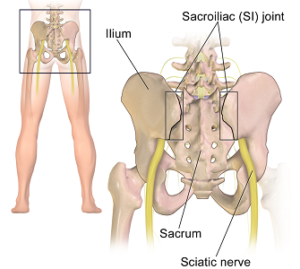
SACROILIAC
The sacroiliac joint referred to as the SI joint connects the sacrum the triangular bone below the lumbar spine to the illium (hip bone). Along with the coccyx, these bones make up the pelvic girdle. The biomechanical function of the sacroiliac joints is to absorb shocks between the upper and lower body.
The sacroiliac joint has very little movement, however, this small amount of motion at the joint site helps aid shock absorption and bending forwards and backwards.
The SI joint is surrounded by strong ligaments, which extend across the joint, to reinforce the strength of the joint. This arrangement of ligaments, limits movement and provides support of the joint while aiding shock absorption.
Muscles such as piriformis and gluteus Maximus also play a role in sacroiliac joint function, stability and shock absorption.
Sacroiliac dysfunction is the cause of 15-30% of low back pain cases.
Symptoms of sacroiliac dysfunction.
Low back pain: A mild to severe dull ache in the low back usually felt on one side, However in some cases, it can be felt on the left and right sides of the low back.
Instability: The low back and pelvis feel weak and gives the feeling like it will give way or buckle while standing, walking, being physical and during transitional movements like sitting to standing.
Spreading pain: Pain may spread to the buttocks, hips and groin. The most common region SI joint pain spreads to is the side of the thigh, upper back and buttocks. Usually, pain is on one side but can be felt bilaterally.
Stiffness: Reduced range of motion can accompany SI dysfunction in the hips, low back, pelvis and groin. Which makes movements, like walking up stairs, bending difficult to perform.
Increasing pain: When loading or adding pressure on the sacroiliac joint, with weight bearing movements the pain gets worse.
Sciatic like pain: Pain that manifests in the buttocks, back of thighs that feels like a sharp stabbing, hot pain and may be accompanied with tingling and numbness. This sciatic like pain as a result of SI dysfunction rarely travels below the knee.
Risk factors and causes of sacroiliac dysfunction.
RSI on the joint: Activites that continually place stress on the joint such as labour intensive jobs, contact sports, regular heavy lifting. Unconditioned low back and pelvic muscles, Static posture like sitting and standing for prolonged periods of time add to SI joint pain.
Gait: Compromised walking such as a limp or leg length inequality, can place uneven pressure on one of the joints, Thus causing wear and tear on the Is joint and increases the pain.
Pregnancy and childbirth: Hormonal changes associated with childbirth cause the ligament to relax and Is joints become hypermobile. Weight gain while pregnant loads the joints which can cause pain within the joint. After childbirth some women’s ligaments remain loose and the instability and pain continue.
Low back surgery: SI joint pain is common following fusion of the lumbar spine. Multi-level low back surgery was more common than single-level surgical procedures. Hip replacement has been identified as a cause for SI joint pain. Changes to the natural morphology of the spine places more stress on the Sacroiliac joints ultimately resulting in wear and tear and pain.
Sacroiliac joint
The sacroiliac joint is a joint between the sacrum and the ilium bones of the pelvis, connected by ligaments.

